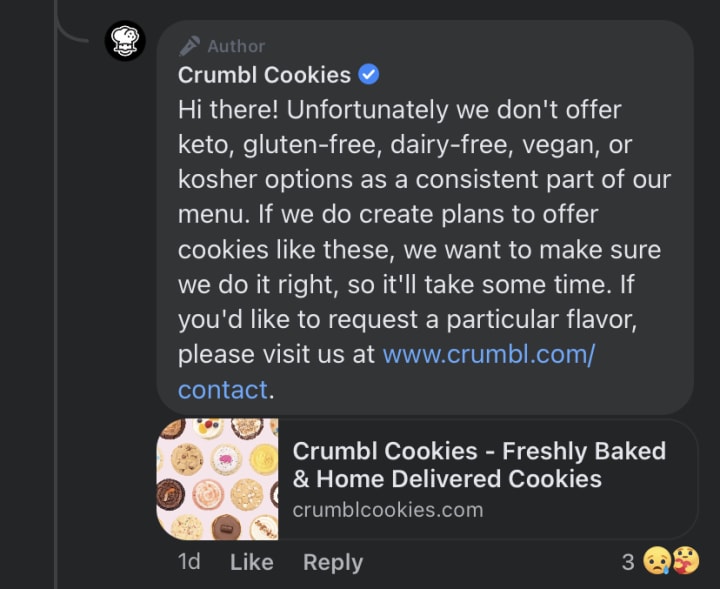Accessibility Means Access To Food
Why restaurant menus that ignore food allergies are ablest and classist, and just plain ignorant.

I was originally writing this as a Facebook rant. Unfortunately for the world at large, I'm off this week and have way too much time on my hands. I spent the morning in conversation with a visually-impaired book editor. We were discussing what conlangs (constructed languages, i.e. fantasy or made up languages like Klingon and Sindarin) mean for accessibility when a person needs a screen reader. Turns out, it generally isn't an issue if the screen reader can read it and the website or story is formatted correctly (lots of food for thought there, no pun intended). That got me thinking about how the world views people with invisible disabilities, like severe food allergies or autoimmune disorders that are triggered by food.
So let me tell you how well I received an ad for a new cookie joint here in Austin that doesn't have a gluten-free, dairy-free, or nut-free option.
Foreshadowing: I was not enthused.
But first, lots and lots of context.
Food Deserts And The Working Poor: An Already Clear And Present Issue
Fortunately in Texas, food deserts are rare. We have a large food industrial complex here called H-E-B. Just about every town has one, or is within 20 minutes of a town that has one. They do amazing things for the state. They provided aid to the victims of Hurricane Harvey in 2017, and didn't all the way shut down during the Pandemic. To compete in Texas with such things as H-E-B, their elite brand Central Market, and H-E-B Plus, department stores had to start incorporating groceries into their locations. I could be wrong about this, but Wal-Mart and Target began offering groceries (in a limited capacity) thanks to stores like H-E-B. We also used to have Albertsons. Kinda miss them.
However, not all H-E-Bs are created equal. Depending on where you are, even in a city like Austin, H-E-Bs can vary greatly in size, offering, selection, and quality. I live on the South East side. There are two H-E-Bs within 5 minutes of me in either direction north or south. The one closest to me is rather small. It has a small produce section (bare bones considering its neighbor just down the way), a very limited gluten-free section, and a very unreliable dairy-free section. Nut-free gets lumped in with gluten-free but they reeeeeaaallly shouldn't be. A lot of folks, like me, have both a gluten and nut allergy. This happens to also be a poor neighborhood of working class people-of-color, so culturally, the offerings and selection are diverse. A grocery chain in an area predominately serving working class minorities can make a more than educated guess that food allergies differ between ethnicities (Dr. Amal Assad, et all, Journal of Allergy and Clinical Immunology: In Practice, November 21, 2016). However, it is presumptive that working class minorities do not experience similar food allergens to their white peers who are traditionally the target audience for most allergen-free foods and allergen care, and it is also presumptive that working class minorities and working class whites do not need access to affordable allergen-free food.
Food allergies in the health care, lifestyle, fitness, and food industrial complexes of America is traditionally a white person problem. This has a lot to do with why stores that have more allergen-free selection can be found in predominately middle class white suburbs. Whole Foods, Sprouts, Central Market, and Trader Jo's are just some of the ones I can name off the top of my head here in Austin. This means accessibility to food, and child care that can see to the needs of children with food allergies, is limited for those without the means to shop at those places (they are very expensive) and the means to travel to them. When so many people have to work and send their children to the school in the neighborhood they live in because it's all within walking distance, food deserts can be created for the working poor who have food allergies. As a working person in the ATX making less than $60,000 a year, I am considered working poor (my friend makes over $200,000 a year. They are considered middle class in Austin). I also have food allergies, and my household only has one car. We've been on food stamps and have had to make use of food pantries to get through just one more day, one more dinner, one more breakfast until payday. We are not alone, either, and it's not even as hard for us as it is for working poor minorities and their children.
Food deserts exist in central and inner city Austin, meaning anyone without a car has to take public transport. That's more of a problem in urban areas of the United States where the working poor and minorities have been forced to live inner city. But let's be real for a second. The only people living in inner city Austin are extremely wealthy or homeless, so let them that can take the Maserati to Trader Jo's on 2nd or Whole Foods on 6th. The homeless situation downtown is another story, which I document here.
So what do food deserts in terms of other local amenities mean for those who have food allergies? If food allergies affect all races, ethnicities, and ages, why is it that so many restaurants and eateries in the United States have few or no options for allergen-free food?
Reverse Classism, Ageism, Ableism, And Food Allergies: Jim's Restaurant
Like most large cities, it has become cheaper to eat fast food than it is to go to the grocery store, but eating out is considered a luxury the working class can't afford. Unfortunately, even eating out in low-income neighborhoods presents an accessibility problem to those suffering with food allergies, and it's coming from places you wouldn't suspect: your average diner.
The ATX is where you come for some of the finest dining in Texas. Scattered throughout the city are fun escapes for those of us with food allergies or vegan dispositions. From Hopdoddy's to a dive bar called The Silver Medal, you can get a gluten-free burger bun and have a great time out with your friends without having to put your gut at risk. Places like Magnolia's, Kerby Lane, and Austin Java give locals the chance to eat out in style without possibly putting your life in danger. But like I said, we can't always afford these places. What we can afford to do is trot our way down to Jim's once a pay period for dinner or breakfast.

Jim's might be a sort of dive-ish joint here in Austin, but in San Antonio, they're as iconic as the Alamo. The original Jim's is right next to the old Crossroads Mall. In Austin, you don't go to Jim's for the ambiance. You go for a cheap breakfast the way the original owner intended. The two Jim's we have are older and run down. It wouldn't be a diner in the ATX if it wasn't. They are extremely popular. Good luck trying to get a table on Sundays. We love going to Jim's because it's cheap, the boy likes it, and the coffee is okay.
They have no allergen-free menu items. For breakfast, I'm stuck with just plain oatmeal and maybe some eggs and bacon. The fun stuff: pancakes, French toast, anything fried, a cheese burger, pasta, the stuff you leave the house for, none of it is allergen-free for me.
Places in working class neighborhoods don't always offer allergen-free products. Restaurants like Jim's--where at any given moment an honored eighty-year-old veteran and families looking for a bit of Texas nostalgia are seated within breathing distance of each other--are ablest and classist because they assume that no person eating there could have food allergies. Their target audience simply isn't part of the assumed section of people that typically have food allergies, especially in Austin, where it's generally working class or working poor that eat at Jim's. Folks with food allergies can eat at places like Kerby Lane.
No, they can't always. Because even their menu is limited for folks with food allergies. And not everyone can afford to pay $12 - $15 for a breakfast plate.
Nor is any attention paid in the slightest to the fact that so many of the older folks that Jim's caters to have GI tract, skin, hair, and hormone issues, and so many of them have not been informed, or even had it suggested, that it could all be because they shouldn't be eating meat, or dairy, or gluten, or sugar (Brophy, Larissa T, MS, RDN, LD, Today's Dietitian. October 2015). Sudden-onset allergies in adults often goes undiagnosed and untreated as a root cause of illnesses in the GI tract, leading to decades of pain and discomfort without ever knowing why. Were you to suggest this to members of the Silent and Boomer generations that their diet is a large part of their health problems, they'd laugh you out of the kitchen.
Which brings me conveniently to my next point.
The Invisible Illness: Food Allergies And Autoimmune Disorders
No one is harder on food-allergy sufferers than our parents and elders.

The health food industry has managed to romanticize fad diets that call for low-carb and high protein meal planning. Cities like Austin, home to the hippie and hipster alike, with our myriad festivals and diverse cultural sensibilities leave the Millennial and Gen Z folks open to polite--or impolite--ridicule about our lifestyles. It's commented by our Boomer and Silent Gen parents that we're more sensitive; that "we didn't raise you that way"; "I ate like this all my life and never had a problem" (newsflash, you got gut health problems and diabetes, Aunt Bee); that we think we're "just too good" for their food.
My sister confessed once to needing to defend our lifestyle choices to my mother, who complained she "couldn't cook us nothin'" because we won't eat it. My sister calmly explained it's not a matter of "won't" but "can't". My twin sister has severe acid reflux that is exacerbated by dairy and high fat proteins, like beef. My baby sister is lactose intolerant. I am allergic to tree nuts and have a leaky gut or gluten intolerance (a little unclear which and doctors simply can't explain it).
But because all my tests came back negative for celiac and other autoimmune problems, and because this illness can be managed with diet and exercise, and because I'm able to work and function as an adult, no one looks at me and sees chronic health issues. Food allergies are an invisible illness.
Food allergens, food intolerances, and autoimmune disorders such as crohns are more common than is being reported simply because so many symptoms don't match the stereotypical reaction to allergens that force people to get tested: anaphylaxis. Though most acute allergy sufferers know what I'm talking about, celiac sufferers, those with leaky gut, crohns, or other GI tract issues don't present with anaphylaxis. Food triggers these illnesses in other near-debilitating ways, ranging from minor constipation, skin issues, and hair loss to acid reflux and GERD, chronic feminine issues, loss of control of the bowel, and unimaginable pain.
And as someone who grew up in the South on Southern cooking, choosing a lifestyle that focuses on health does look a little bougie. But when you have an allergy to a food or a series of allergies, you can't eat the same way everyone else does, so you are forced into a healthy lifestyle change that cuts out many of the foods that contain the allergen: fried foods, dairy products, anything with soy, sometimes even things with synthetic flavors, sugar and sweets, sodas, and processed food. But when it comes to events, family fun, holidays, and special occasions, food allergy sufferers can unwittingly cause offense by refusing to eat something they are allergic or intolerant to, or are forced to bring their own food. Not everything results in anaphylaxis. That's just one allergic reaction. Refusing Aunt Bee's Banana Puddin' just ain't right. Well, I'm sorry. I don't want my hair to fall out and my stomach to swell up.
Thanks to fad diets, classism, ableism, and ageism, the assumption that--like most invisible illnesses--we can just resolve the issue at any time simply by changing mindset, exercising more, or just plain sucking it up pervades the restaurant industry to the point that even in Austin, people still think allergen-free options aren't in demand. A new cookie company in Austin, Crumbl Cookies, is offering up new and creative confectionary offense to those of us just trying to have a good time and not die.
Calling Out A Local Cookie Co.
With so many options and competition, why is it that even the nicest and funnest places in Austin have no allergen-friendly offerings? I'm speaking about some of our biggest tourist attractions, our specialty foods. Typically, these are confections, and it's not across the board. Things are changing rapidly in this town, but it's still relegated to the middle and upper class, so getting access to some of this stuff is nearly impossible at a decent price point in your own neighborhood, even if it is mass-produced.
I saw a post from Crumbl Cookie, a brand-spankin' new sweet spot here Bee Caves (west of Austin) advertising their delicious confections. Like anyone with a sweet tooth, I checked to see if they offered anything gluten- and nut-free. To my disappointment, they do not. You can add this place to the list of places that I won't be eating at, and even when they do offer a GF an NF options, I still won' be going there because of this:

Why would this upset me, you ask? First of all, we need another cookie place in this area like we need more traffic lights. You can't walk down the block in suburban, inner city, or greater Austin area without tripping over a specialty baked-goods shop. Do I want another Juiceland on the East Side, yeah I do. But that's not what's got me mad. I'm mad because in this day and age, with so much knowledge about cooking and baking for food allergens in Googleing distance of any able-bodied person with two thumbs and a phone, and with the current demand for allergen-free options so high, it's outrageous to me that not even a single gluten-free or nut-free option was offered when they launched the brand. Not only that, but
"if we do create plans to offer cookies like these..."
IF? You mean that's not even in your business plan yet? And yet further insult to injury,
"we want to make sure we do it right, so it'll take some time."
Really? I do GF, Vegan, DF, NF desserts as Christmas gifts out of my kitchen!
Brace yourselves because I already have rebuttals to all arguments in their defense.
1. There isn't as much demand: tell that to their comments section.
2. It's difficult to produce at scale: so Nabisco must be suffering pretty hard. They have tasty GF Oreos.
That's a crap argument because the sheer variety of available allergen-free options you can get mass-produced--for the right price--is actually rather staggering. Depending on your allergy and your location, you can even get non-gmo, fair trade items as well, so not only is your food not going to kill you, it's better for the economy and the environment. In a bakery situation, you are already mass producing to a certain extent to keep up with demand on a daily basis. Devoting some time to allergen-free food is trivial. Using time wisely is just good business.
3. It's just too difficult to source ingredients, or coming up with a recipe is going to take too long: no, it isn't, and no it won't. There are many widely available brands of allergen-free flours, and even nut based flours. When used correctly, it is possible to produce a recipe that is satisfying and appetizing. With fresh ingredients like squash and carrot for moisture, ghee for nonstick, and psyllium husk for elasticity, there is no excuse for not being able to source ingredients. Not to mention the fact that some folks who have been dealing with allergies their whole life have spent decades perfecting techniques and recipes for themselves and their children to deal with the deficit of allergen-free options. Many of them make this knowledge available on the Internet so some other someone doesn't have to work as hard as they did. And you can even work the cost of the pricier baking ingredients into the price of the finished product when you mark it up 300%. Sheesh, everyone else does.
4. We don't have the space: not that this needs to be longer, but lemme tell you a story.
When I was in my 20s I worked in a little tiny Greek restaurant in San Antonio called Papouli's. The entire kitchen was less than 1000 square feet. I could fit my entire downstairs in the kitchen, dish room, and walk-in fridge, freezer, and dry storage. We did sell what you could consider gluten free products if you didn't eat the Gyro (there's wheat in it). A straight salad with a chicken skewer and side of humus or tzatziki...there's a reason I worked there for two years after I graduated college. Sometimes a celiac person would come through and let us know up front if they had the allergy. We had a standard operating procedure for celiac sufferers that had to be followed to the letter on pain of losing your job. We had separate clean cutting boards, separate knifes, and prepared their food in a separate section of the kitchen, in less than 1000 square feet of space. We found a way to reasonably accommodate people with food allergies and we were happy to do it.
5. They don't taste or feel the same as traditional baked-goods: well, no, that's true, they don't. Traditional baked goods use eggs, flour, oil or butter, and refined sugar to be decadent, moist, flavorful, and hold up after baking. But you know what, people who can't eat any of that stuff don't even actually crave it unless it's waved in our faces. Some of us do know the difference between a real brownie and GF one, but when it comes to what we'd rather eat, we'll choose the GF one every time. For example, check out this awesome recipe by the Betty Rocker.
I eat these all the time. Eating in ways that caters to our allergies means we can eat just as well as anyone else without sacrificing our comfort or health and safety. I love those pancakes. I can eat a whole stack without feeling sick and I don't have to worry that I'm going to have to spend 3 weeks eating rice and plain chicken to bring the swelling back down. Diabetics and gestational diabetics beware of that recipe: it uses banana.
Sure watching cooking shows is a little hard, but there are plenty of ways to get a good meal or dessert that doesn't involve harming ourselves. And done right, you won't have any trouble selling them.
Conclusion:
Well what started out as a Facebook rant at 9:50am this morning has turned into 3700 words about five hours later.
Ableism and classism create food deserts not just by cutting the working poor off from affordable and accessible allergen-free food, but also by forcing us to do for ourselves what can't or won't be offered to us in restaurants. Additionally, these types of food deserts disproportionately affect working class minorities and people of color. Traditional modes of thinking and media misinformation fuels an overall image of health-conscious people as a bored white middle class with more money than sense, which means lower income families suffer due to lack of availability of selection, affordability, and accessibility. Ignorance and lack of funding reduces access to information at the municipal level to bring awareness of food allergen deserts to the people that need it most and reduces the likelihood of correcting shortages of allergen-free products in food pantries and food banks. The refusal of the restaurant and grocery industries serving the working poor to acknowledge food allergies as an accessibility issue means the perpetuation of the lie that just because you don't look sick doesn't mean you don't have chronic health issues, and continuing ageism among the Boomers and Silent Gen that raised us creates additional trauma.
For those of us with acknowledged and diagnosed food allergies, refusal to offer allergen-free menu items is a gross act of negligence that is an attack on the working poor as a whole. In addition to not being able to enjoy pregnancy, our children, basic comforts, affordable housing, and affordable health care, we can't even eat out as a treat. The Heavens forbid a poor person who is celiac or who has any other food allergy might like to have dinner in a nice place, even if it is Jim's once a pay period.
About the Creator
Ashley McGee
Austin, TX | GrimDark, Fantasy, Horror, Western, and nonfiction | Amazon affiliate and Vocal Ambassador | Tips and hearts appreciated! | Want to see more from me? Consider dropping me a pledge! | RIP Jason David Frank!
Enjoyed the story? Support the Creator.
Subscribe for free to receive all their stories in your feed. You could also pledge your support or give them a one-off tip, letting them know you appreciate their work.
Reader insights
Outstanding
Excellent work. Looking forward to reading more!
Top insights
Expert insights and opinions
Arguments were carefully researched and presented
Eye opening
Niche topic & fresh perspectives






Comments (4)
Very eye opening and informing. I have a close friend who has a son with food allergies. I appreciated the links to info. Outstanding piece.
Totally relatable, my daughter has severe peanut and tree nuts allergy, my family also struggle in social gatherings and parties when unlabeled food is offered . Thx for sharing.
Great content! A lot of agreement with you and your rant. Such a preventable shame and apparent apathy there. Here in the UK as in my hometown, there is lots of choice for all categories and it is taken very seriously. I just finished an article recently about GF bread. Thank you for writing, sharing, and ranting like you did. It was needed.
Great article. Well done.